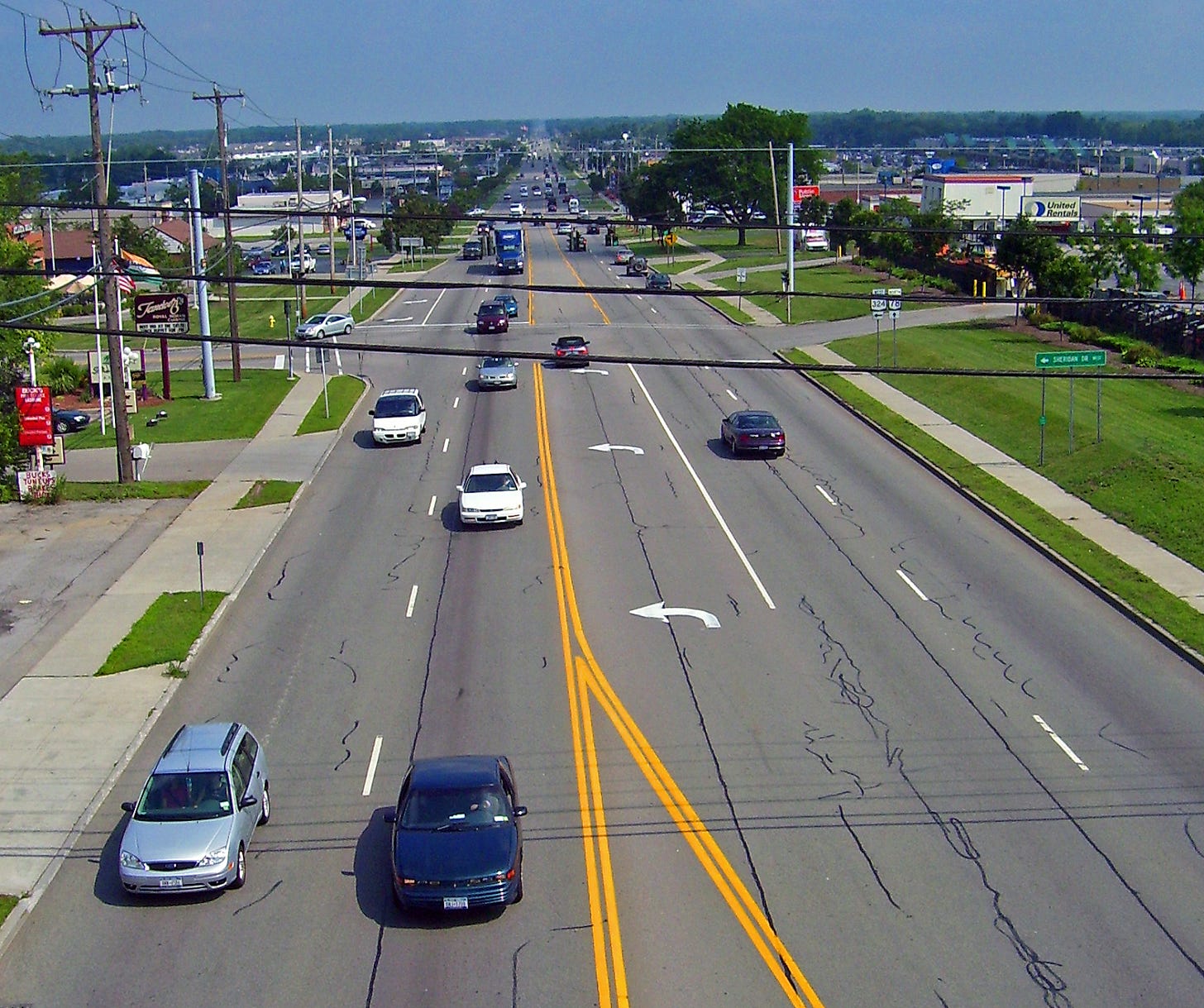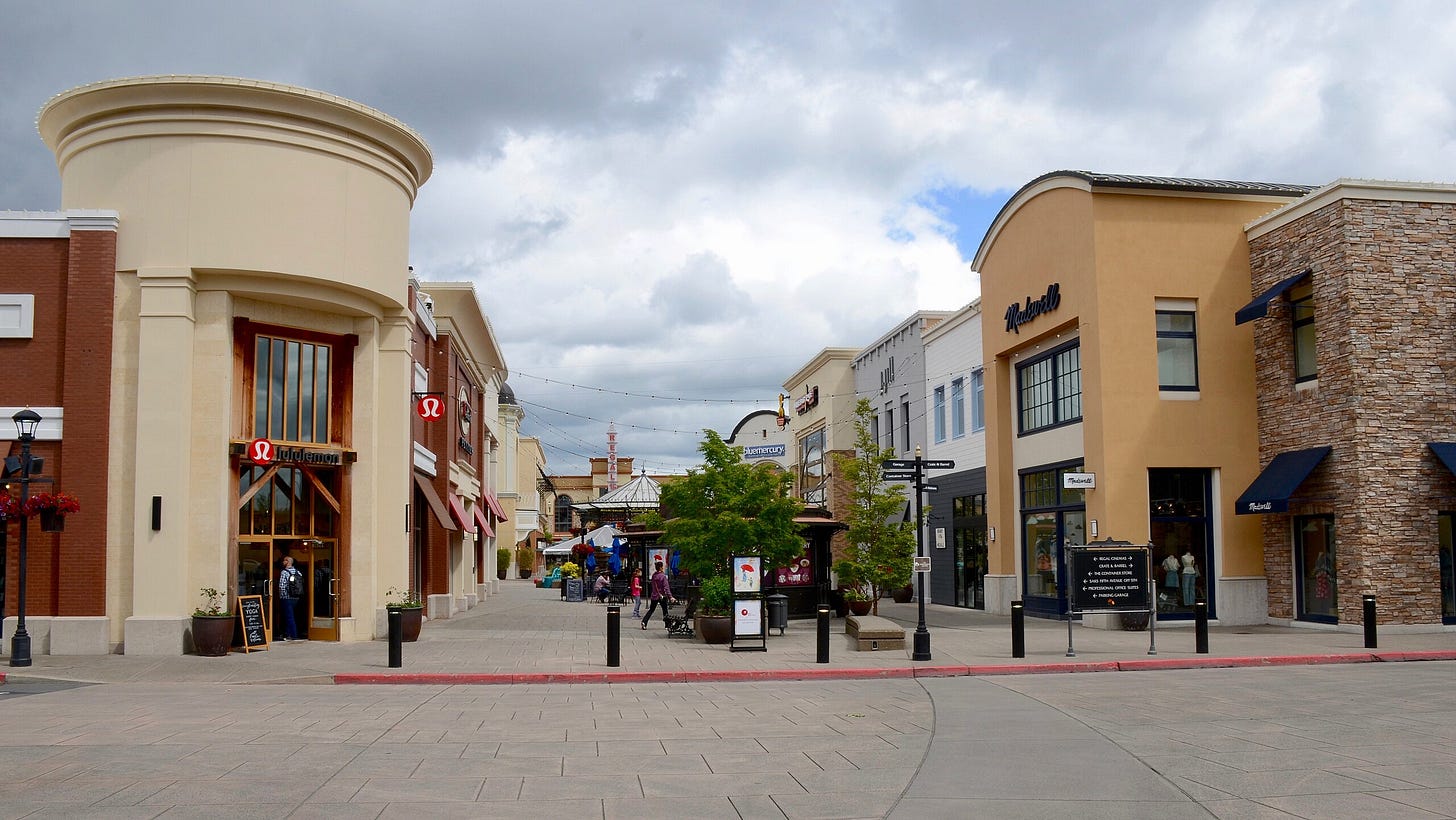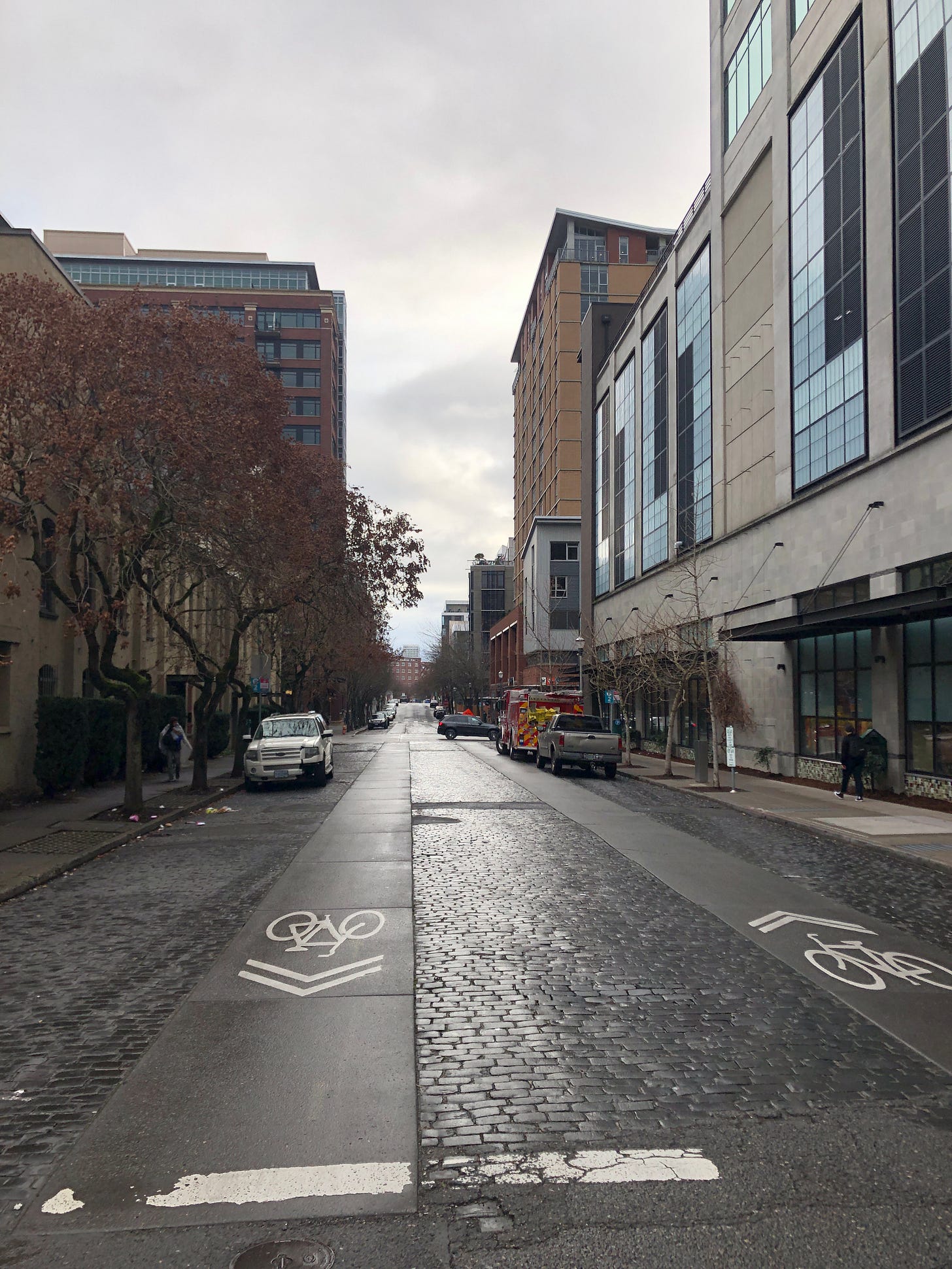Commercial Density and the Walkable City
Activating City Streets
Population density serves as a crude but effective proxy for good urbanism. If you sort major US cities by population density, a pretty clear cluster of top-tier cities emerges: San Francisco, Boston, Chicago, Philadelphia, and DC all have population densities from 11,000-19,000 people per square mile.1 This makes up the “A-tier” of American urbanism. New York City’s population density is almost 30,000 people per square mile. If you zoom in on Manhattan, the population density is almost 75,000 people per square mile. New York is the one and only “S-Tier” American city.2 To look at a more granular proxy than pure population density, another marker of quality urbanism is commercial density.
Jeff Speck’s book Walkable City details four conditions for great walkability: the walk must be useful, safe, comfortable, and interesting. To improve walkability, most American suburbs and car-centric cities need to start with the basics of just making walking useful and safe. In the “A tier” though, much of what makes a city feel exceptionally walkable is in the walk being comfortable and interesting. It feels uncomfortable to walk along a street that is too wide, with too much or too fast of car traffic. It feels uncomfortable to walk at night when a street is barren of other people, due to the “eyes on the street” principle. Speck also makes the point that we instinctively feel more comfortable in streets that are more enclosed by buildings, like an outdoor room.
As for the interesting walk: commercial density is what creates interesting and vibrant public spaces. We are a social species. Even if you aren’t doing any shopping, just being in a place where other people are hanging out is inherently interesting. Even at high population densities, purely residential streets can often be quite empty of people. There’s nothing for people to linger at, on a residential street. Even a single corner store or neighborhood cafe can make a street start to feel like a place. This is what’s so important about commercial and mixed-use zoning in creating walkability. A lot of people walk through cities and inherently feel this distinction between dead zones, and the interesting streets where stuff is happening, but never really understand why one block has a bar on the corner and another doesn’t.
Population density is such a useful proxy for urbanism because it enables both commercial activity and high-frequency public transportation. You need a critical mass of customers to make an interesting commercial street. You need a critical mass of fare-paying riders to enable high quality public transportation. Both of these are crucial to getting people out of cars, which enables a virtuous cycle where less space needs to be taken up by travel lanes and parking spaces, which further enables density and walkability. Andrew Burleson recently wrote a great piece on this “geometry problem” of car dependence.
Lessons from Suburban Commercial
We can learn many lessons about urbanism and walkability from looking at suburban commercial. The enterprise of suburban zoning is to create as many quiet, peaceful, boring, safe residential streets as possible, by concentrating all commercial activity and noxious car traffic on the same thoroughfares. Suburban zoning treats commerce itself as a noxious land use. So strip malls go right on the nastiest arterial road in town, so that commerce doesn’t “pollute” the nice quiet streets. The failure of these car-centric strip-mall developments is many-fold, but at the core of the issue is that arterial roads and big parking lots are unsafe, uncomfortable, and uninteresting—this is obviously true for pedestrians or bicyclists, but true for the drivers as well. These environments are supposedly optimized for driving, but they fail even at that.3

There should be a natural progression where as a town’s population grows, it can support more commercial density. Increased density of these useful destinations should enable useful bike trips, and then walking trips. Eventually the town should even fill out enough to have the kind of density that supports public transportation. But if all the useful destinations are concentrated on stroads that are hostile to walking and biking, then this creates the vicious cycle of car dependence and housing shortages, where any increase in population also increases car traffic and difficulties with parking.
As far as suburban commercial activity goes, malls are much more successful at being safe, comfortable, and interesting walking environments than strip malls or power centers. “Lifestyle centers”—which create simulacra of urban commercial streets, but surrounded by parking lots like suburban malls, and lacking the apartments on top—are not really an improvement on malls. If anything, their walking environments are less safe since cars have been brought back into the picture, and less comfortable in most climates, since moving outdoors removes the mall’s advantage of climate control.

The best suburbs have concentrated commercial activity in revitalized or newly-created downtown/main street urbanism. Addison Del Mastro’s piece If You Build It, They Won’t Care details an excellent suburban downtown redevelopment very near to where I grew up. As a snobby urban 20-something, I go to this adjacent suburb to meet an old friend for a coffee or a beer basically every time I visit home, as opposed to going to a strip mall in my own hometown. Because this is a genuinely nice place to hang out and walk around in, and strip malls… aren’t!4 Ray Delahanty talks about some great suburban main streets along the Bay Area’s CalTrain corridor in this video.
In my previous piece, I discussed the economist James Buchanan’s idea that the “rational fiscal strategy” for suburbs is to directly compete for affluent residents, because failing to appeal to them will quickly destroy your town’s property values, and therefore your tax base. These nice suburban downtowns are an increasingly common feature of affluent, thriving suburbs. I anticipate that suburbs that don’t build walkable downtowns are going to struggle in years to come, as Millennials and Gen Z have much more positive associations with urbanism than the Boomers did.
Deploying Commerce Where it is Needed
Returning to a more urban context: higher commercial density can make a place really interesting, but a given population can only support so much commerce. Concentrating commercial activity too heavily can come at the cost of other streets feeling too dead. Of course, people like living on quiet residential streets near the action, and striking this balance between interesting streets and quiet, peaceful streets is one of the big goals of restrictive zoning.
Manhattan is peak urbanism because with the exception of certain blocks of mid-century redevelopment blunders, you can meander from anywhere to anywhere and your walk will be comfortable and interesting. The A-tier cities lack the population to support vibrant commercial streets around every corner, so they are more reliant on networks of interesting commercial streets. At these medium-high densities, finding the most comfortable and interesting walking routes through the city requires more accumulated knowledge of the city.5 And sometimes, even in the A-tier cities, there are gaps in the walking network where you’ll just be stuck walking somewhere uncomfortable and liminal to get from point A to Point B.
To my mind, a classic gridded American city would be incredibly well served by having a north-south and an east-west commercial street every several blocks that is optimized for pedestrian and bike safety, with minimal car traffic. This would essentially be the opposite of the famous Barcelona Super-Block—instead of having a superimposed grid of arterials for moving cars, with limited through traffic in between these arterials, you’d have a superimposed grid of commercial streets optimized for the useful, safe, comfortable, and interesting walk.
Among other issues, one of my major quibbles with urban malls is that they concentrate commercial activity off the street, when that commercial activity is a limited resource that should be deployed throughout the city to create a useful network of comfortable and interesting walking routes. Noah Smith praises Japanese “zakkyo” buildings here, but I think trying to apply zakkyo in any American cities besides New York would be misguided. Just like more population density has diminishing returns in terms of livability and urban convenience, more commercial density has diminishing returns in terms of turning a street from “boring” to “vibrant.”

In the densest parts of Tokyo, there is so much commercial activity that it must be concentrated in zakkyo in order to preserve some quiet and peaceful areas. But in most American cities, too many streets are “quiet and peaceful.” In excess, quiet, and peaceful instead becomes dead, liminal, boring. We don’t want to eliminate boring residential streets: they’re nice places to live. But we do want to find and plug gaps in the network of “interesting walking routes.” The interesting walk is easily attainable by sprinkling small doses of neighborhood cafes, bars, and convenience stores onto otherwise mostly-residential streets without compromising their mostly “quiet and peaceful” nature.
Jeff Speck’s criteria for walkability point to a core insight about the intersection of commercial zoning and transportation planning. Safety and comfort are incompatible with high speed car traffic; and the most comfortable and interesting walking route is usually on a commercial corridor. So to create an exceptionally walkable city, where walking is truly a desirable and enjoyable way to get around, you need an interconnected network of commercial streets that prioritize the pedestrian experience over the automobile through-put. The interesting walk is what separates great urbanism from merely good.
Surprisingly, so does Miami, but since density is a crude proxy, I will make the executive decision to exclude Miami from this tier due to its comparatively mediocre public transportation and walkability.
This doesn’t mean I think New York is objectively superior, only “more urbanist.” I certainly value urbanism, but also acknowledge that it comes with trade-offs, and past a certain point, diminishing returns. My personal ideal is probably more urban than my beloved SF, but less urban than Manhattan. While San Francisco NIMBYs bemoan the “Manhattanization” of San Francisco, as a YIMBY, I am happy to compromise at the mere “Brooklynization” of San Francisco, which would still be almost a doubling of the residential capacity of the city.
My hometown’s own “main street” is actually pretty good, but is much less connected to public transportation, and is tucked away on the edge of town instead of being right off the main drag.
As a newcomer or tourist, the quickest way to identify these walking routes is to try to stick to the streets highlighted in yellow on Google Maps (or purple in Apple Maps), but these highlights are highly imperfect. They highlight some streets that are not particularly pleasant to walk on, particularly in less urban places; and in more urban places, they omit lots of streets that are quite interesting and pleasant.



The commercial density and interesting streetscapes are one of my favorite things about living in Manhattan. The street level storefronts of small rise buildings can offer dozens of store varieties in a single block. Large scale developments have changed this feeling. Developers have (understandably) opted for the reliability of large box store footprints rather than multiple small scale vendors. Post Covid a record number of Walgreens/cvs/etc have closed leaving full intersections vacant. The economics of these stores have changed and I don’t see them coming back. My hope is that developers will convert these large single vendor storefronts into multiple varied and interesting vendors. Good for the street and ultimately their investment as it once again it becomes an interesting place to live.
Walkable City was the first book on Urban Design I ever read, it changed my life.